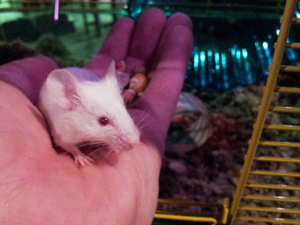
In Wilkie Collins' early Victorian thriller, The Woman In White, the villainous Count Fosco is fond of small animals—even to traveling accompanied by a collection of caged birds and mice. Robert Kauzlaric's adaptation for Lifeline Theatre dispenses with the portable aviary, but retains the rodent contingent with a cameo appearance by a genuine live mouse.
"Fosco's affection for his pets—in several chapters of the novel, he is, literally, covered in them—lends him a certain charm that gradually gives way to menace," observes adapter Robert Kauzlaric, "While we couldn't completely realize that vivid image in so limited a space, we thought that a short scene with at least one live critter would go a long way to capturing that feeling."
The Count and Countess Fosco arrive carrying three miniature pagoda-like cages strung on a rod like that of a carnival peddler, but these are occupied solely by painted mannequins, says Kauzlaric. Fosco's mascot figures in the play's action for only one scene, where the urbane aristocrat expounds on his curious menagerie while cuddling one of his furry charges.
"We have two mice alternating in the role—named Fanny and Hester, after characters who appear in the novel, but not the play," Kauzlaric explains, adding that Fanny is the more outgoing of the pair, and so, is most frequently the one seen onstage. Between shows, the performing fauna live in the Lifeline offices above the auditorium. "In my capacity as Lifeline's marketing director, I'm at the theater seven days a week, so it's easy for me to take care of them. Mice are nocturnal, so they mostly snooze in their cage on the shelf behind my desk—though Fanny likes to get up every few hours for some water and exercise."
How much rehearsal did Fanny and Hester require? "They were introduced to the company near the beginning of rehearsals, and after we moved into the theater, they would sit with me as they got used to the fuss and bustle. We were a little concerned about their reaction to the lights and music, but they didn't seem to notice."
Christopher M. Walsh, who plays Fosco, is a large man and when he cradles Fanny or Hester in his cupped hands, a few playgoers interpreted this to mean that he was shielding the tiny captive from the surrounding hullabaloo. Kauzlaric stoutly refutes this impression. "Oh, Fanny takes in everything going on around her! During the part where Fosco holds her up near my face, often she'll sit up on her hind legs and say hello. Chris' hands provide her a more comfortable environment to explore than if she were surrounded by open space."
So what's the pre-performance ritual for these non-equity Minnies? "During the show, their cage is kept in the greenroom on its own table. Just before the scene, they are transferred to a smaller cage backstage where Chris can easily find them. Then, after the scene, they are returned to the greenroom and Chris has a break to wash his hands before his next entrance."
How have playgoers responded to these beasties? "We wondered about that," Kauzlaric confesses, "It takes our average audience a minute or two to realize that the mouse is real, during which you can hear the recognition spread throughout the house. There's lots of cooing, but occasionally, we hear a grunt of discomfort. Fortunately, the scene is brief enough that Fanny is back in her cage before anyone has time to get antsy."
Where do Fanny and Hester intend to retire after the show finishes its run? "They'll come home with me," Kauzlaric replies, "Unless the rest of the Lifeline administrative staff—Alex [Kyger], Allison [Cain], and Dorothy [Milne]—just can't bring themselves to say goodbye to our little friends."
The Woman In White runs at Lifeline Theatre through October 28.
Mary Shen Barnidge
Contributing Writer

 Follow Us On Twitter
Follow Us On Twitter